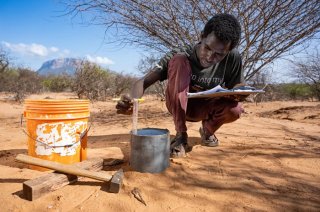
category_news
How land management can improve water security in Africa
A study based on a massive data set spanning 19 countries in sub-Saharan Africa offers hope for improving water security for millions - through restorative management practices. For many people in sub-Saharan Africa, reliable access to freshwater is not guaranteed year-round. As much as 90 percent of agriculture depends on water from rainfall, and groundwater is a critical source of freshwater.
The replenishment of soil and groundwater depends on whether and how water at the soil surface enters the soil, a process known as infiltration. One can think of soil as a sponge with pores. The larger these pores and the more there are, the more easily and rapidly water will infiltrate into the soil. This porosity depends in part on soil texture, the relative proportions of sand, silt and clay particles, but also on soil structure, how individual particles are assembled and arranged.
When infiltration is poor, water accumulates on the soil surface, resulting in surface runoff and low recharge of soil moisture and groundwater. This surface runoff, in turn, can lead to soil erosion and flooding. Maintaining and enhancing soil infiltration capacity is thus critical for improved water and food security.
Filtering through decades of data
A new study led by researcher Aida Bargués Tobella at the Swedish University of Agricultural Sciences (SLU) sheds new light on the factors influencing soil infiltration capacity in sub-Saharan Africa. The study analyses data from over 3500 plots across 19 countries, spanning different climates, soil types and land uses, from grasslands to forests. The data set includes measurements of infiltration, vegetation cover, and various soil properties.
The results show that soil infiltration capacity is affected by numerous factors. Soil texture is key, but there are also many other factors related to soil structure that are influenced by management, including soil organic carbon content, livestock stocking rates, or vegetation cover. For example, areas subjected to heavy grazing tended to have lower infiltration capacity due to animals trampling and compacting the soil, while areas with a higher cover of woody vegetation benefited from the enhanced porosity from litter and roots.
Promising results for improving soil health and water security
By making sure to maintain and rebuild the soil structure, the soil sponge, we can ensure there are sufficient pathways for water to infiltrate into the ground. The impact of these structure-altering processes on infiltration capacity brings hope for improving water security in the region, says co-author Douglas Sheil of Wageningen University.
"Millions in sub-Saharan Africa face daily hardship due to water scarcity, and this is expected to worsen. Our research offers hope by showing that people can manage their land to mitigate this crisis. Our research shows that practices, like promoting tree cover, can significantly improve water absorption and replenishment, ultimately boosting groundwater reserves and water security", says Douglas Sheil.
Unique data can help predict effects of extreme weather
This unique data set of soil infiltration measurements and other indicators of soil and land health will be extremely valuable for improving hydrological models for applications in Africa. The data set expands databases of soil hydraulic properties, improving coverage for Africa and providing much-needed field data for underrepresented land uses and soils.
Under a future climate with more extreme weather events, such as heavy rainfall and drought, these data will become increasingly valuable in identifying which areas are more prone to flooding or drought, which is essential for strengthening existing Early Warning Systems.